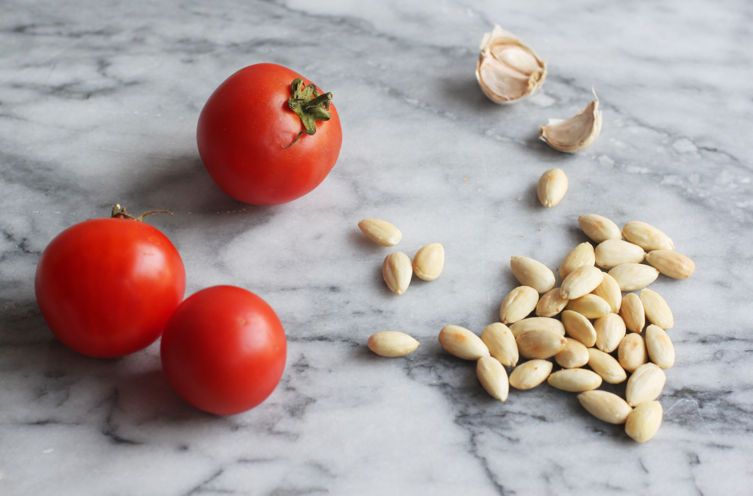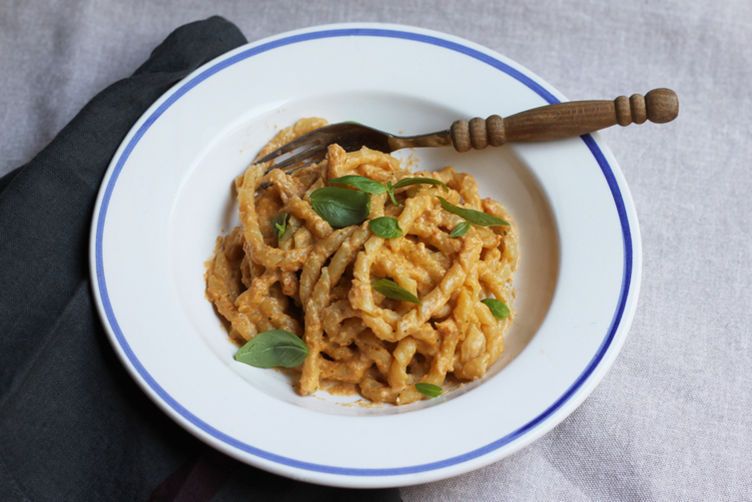Every Tuesday, Italian expat Emiko Davies is taking us on a grand tour of Italy, showing us how to make classic, fiercely regional dishes at home.
Today: Sicily's take on pesto is a fresh, refreshing almond and tomato sauce.

This delicate, refreshing pesto is named for its birth place, the town of Trapani in the western corner of Sicily. The recipe is centuries-old, and likely inspired by Genova's more famous basil pesto, brought over by Ligurian mariners stopping off in Trapani's port. The locals then adpated the pesto recipe with their own local ingredients -- most notably, almonds and tomatoes. Others suggest it was inspired by Liguria's agliata, a garlicky sauce made with garlic, walnuts, and both fresh and sun-dried tomatoes. Regardless of where the recipe came from, one thing is for sure -- you shouldn't skimp on the garlic here.
More: You can use up your garlic in this pici con le briciole, too.
A food processor makes this a super-quick meal, but don't let anyone from Trapani see you using one: Locals insist with great fervor that there is only one way to make this pesto and it is in a mortar and pestle. They say the texture and color are affected by the processor's metal blades: The basil oxidizes when it comes in contact with metal, which often results in a dark, brownish color to the pesto. For those willing to use a mortar and pestle, it's still a fairly quick task, and you'll be rewarded with full points for completely handmade, Sicilian-approved pesto, with the best possible texture and flavor.

You rarely find any variation in this recipe, except for when you begin to move out towards the edges of Trapani where some cooks add grated bottarga or even tinned tuna to the mix. At its most basic, the recipe's heroes are the blanched almonds, ripe tomatoes, and garlic. Giorgio Locatelli uses mint leaves instead of basil; other cooks add mint as a garnish, especially in the summer when it gives a refreshing lift.
The pasta that this pesto dresses is served both cold and hot, and is almost always with busiati: long, corkscrew-shaped fresh pasta made from wrapping a dough of semolina flour and water around knitting needles to give it its distinct shape. Fusilli, although short, could be a good substitute if you can't get or make busiati. This pasta is commonly served with a rustic garnish of toasted breadcrumbs, which can be thought of as poor man's Parmesan cheese -- but you can substitute cheese if you prefer. It's also not a bad idea to serve this as a sauce to accompany grilled vegetables or seafood.

Pesto Trapanese
Makes about 4 servings
10 ripe plum tomatoes, peeled, seeds removed, and chopped
1/2 cup (85 grams) blanched almonds
4 garlic cloves, peeled and roughly chopped
Handful of basil leaves, torn
3 to 4 tablespoons olive oil
1/3 cup toasted breadcrumbs or Parmesan cheese, for serving
Salt and pepper
See the full recipe (and save and print it) here.
Photos by Emiko Davies





See what other Food52 readers are saying.